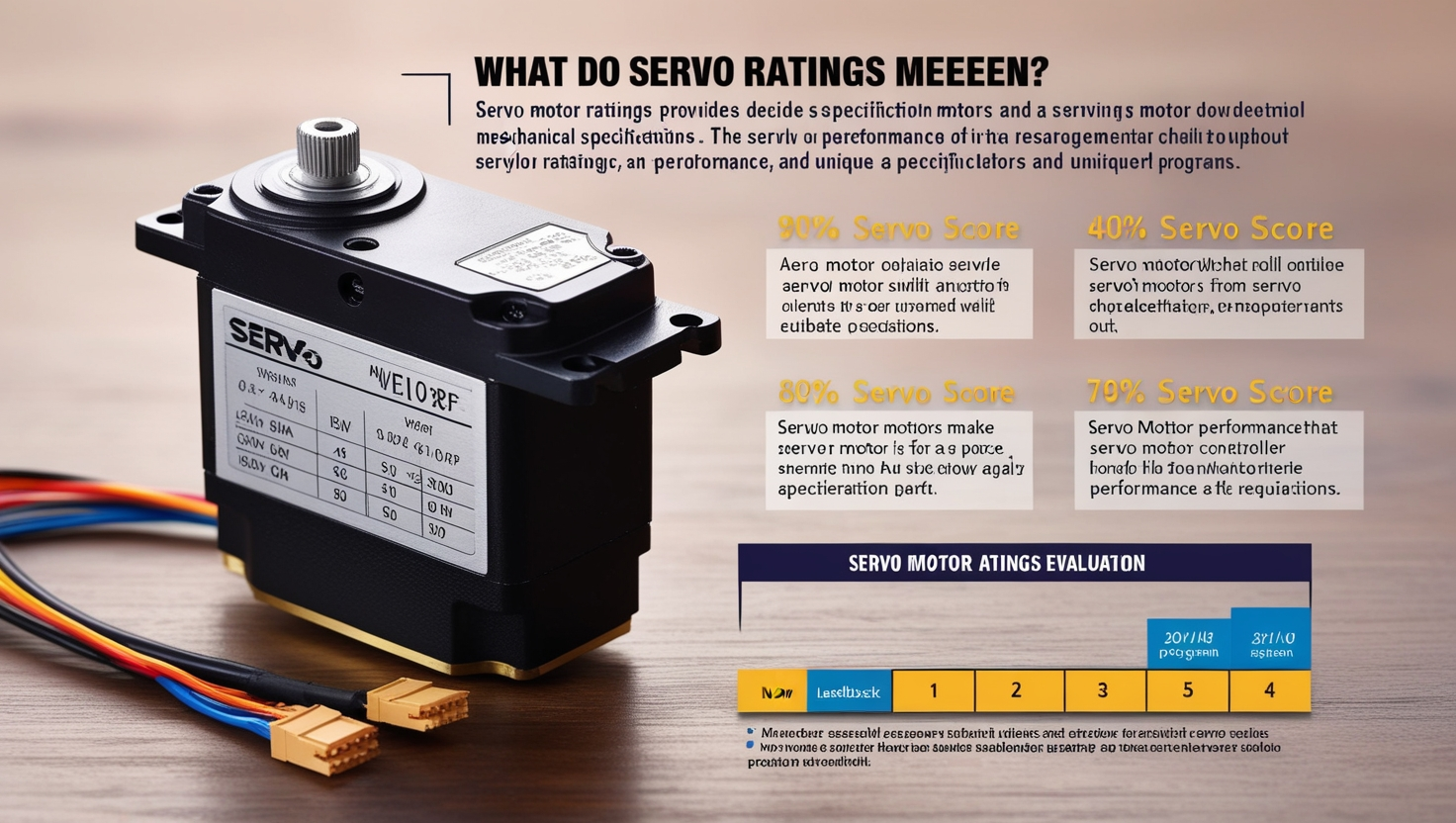Introduction To What Do Servo Ratings Meeeeen
When researching the world of servo motors, one may come across the term “servo score.” If you’re asking, “What Do Servo Ratings Meeeeen?” you are not alone. Servo motor ratings are essential specifications that decide servo motors’ performance and capability in various programs. This article will delve into these means and the importance of servo motor evaluation, highlighting their role in ensuring that servo motors meet the needs of unique responsibilities and how they can affect the overall performance of a mechanical device.
What is a servo motor?
Before we dive deeper into servo motor evaluation, it is essential to recognize what a servo motor is. A servo motor is a small but powerful electric motor used in many mechanical structures to control angular function, pace, and acceleration specifically. These cars are usually used in robotics, automation, aircraft, drones, and many other fields that require extreme precision and precise control.
A servo motor normally includes a motor, an annotation tool (along with an encoder), and a controller. The feedback mechanism allows the machine to continuously detect the motor’s position, ensuring that the motor adapts its movement to maintain the preferred position.
Now, leaderboards for servo vehicles provide valuable information about their skills and overall performance characteristics. So, “What Do Servo Ratings Meeeeen?” Let’s break down the essential factors that are protected in these scores.
Key components of servo evaluation
A servo score typically includes numerous specifications that describe the motor’s performance in a given software. These ratings help technicians and users select the right servo motor for their needs. Some of the maximum critical specifications discovered in the servo score consist of:
Torque rating
The torque score is one of the most critical specifications in evaluating a serve. Torque refers to the rotational force a servo motor can produce. Torque is often expressed in Newton meters (Nm) or ounce inches (ozins) units. Determining how much or load the servo motor can move at a given rate.
When as is essentialked, “What Do Servo Ratings Meeeeen? ” Rated torque is often one of the first things that is not forgotten. A higher torque score allows the engine to handle extra-extended loads or heavy-duty duties, while a lower rating indicates more weight and a much less efficient engine.
Speed rating
Speed is another essential element when evaluating a servo’s rating. The rated speed describes how fast the motor can spin, typically given in revolutions per minute (RPM). Speed ratings are essential for packages that require fast movement, including robotics or computerized machinery.
For example, if the machine needs to perform fast turning or adjusting, selecting an overspeed servo motor is essential. If you’re asking, “What Do Servo Ratings Meeeeen?” when it comes to pace, think of it as the engine’s ability to reach and maintain a certain pace to accomplish its task.
Rated voltage
Servo cars also have a voltage score that defines the operating voltage needed to power the motor. Most servo motors operate on direct (direct current) power, although AC (current AC) servos are also used in positive applications. The voltage rating offers critical information about the power supply for the most reliable motor performance.
In applications where the motor is powered through a specific voltage source, information about the rated voltage is essential to avoid underperformance or damage. The voltage on the servo rating helps you recognize how much electricity the motor needs to perform correctly.
Current rating
A servo’s peak score tells you how much peak the motor wants to run at its rated performance stage. This Score is regularly given in amperes (Amps) and is essential to understanding the motor’s energy intake. Higher-end servos typically require more current, which can affect the overall performance of your machine.
In addition, top performance makes it easier to decide on the appropriate power supply and ensures that the engine is not always overloaded. If you’re asking, “What Do Servo Ratings Meeeeen?” nowadays, consider the amount of electrical electricity a motor needs to operate efficiently.
Torque retention
Holding torque refers to the torque a servo motor can have without moving when it is powered but no longer actively rotating. This Score is significant in applications where the servo motor wishes to maintain a selected position under a load consisting of robotic fingers, drones, or CNC machines.
Holding torque is essential for precision control applications because it ensures that the servo motor can keep the object in a fixed position without slipping or drifting. If you’re curious approximately “What Do Servo Ratings Meeeeen?” in the context of torque hold, it’s the engine’s ability to keep things going even when needed.
Feedback mechanism
A crucial part of evaluating professional servo motors is a feedback machine constantly monitoring the motor’s position. Most modern servo cars use encoders or resolvers to provide feedback to the driver. This feedback mechanism allows proper control of motor function, pace, and acceleration.
The note system allows you to save the motor from overshooting its target role or being risky, so it is an integral part of servo motor evaluation. Without proper comments, the servo could lose accuracy, which would compromise the entire system’s capabilities.
Why is server rating critical?
Now that we’ve broken down the various components of a serve score, you might ask, “What Do Servo Ratings Meeeeen?” in a realistic experience. These rankings are crucial for several reasons.
Ensuring compatibility
Understanding the servo drive score ensures you choose the right motor for your device. If a servo motor has a torque or speed score that is too low for a given application, it cannot handle the specified load or perform tasks quickly enough. On the contrary, choosing a motor with too much power can result in unnecessary power intake, reduced efficiency, and undoubtedly better costs.
By comparing the ratings of different servo motors, you can ensure that the motor you choose is well-matched to your system’s needs. Without the proper expertise, “What Do Servo Ratings Meeeeen?” in this context, you risk choosing the wrong engine, which may result in machine failure or inefficiency.
Performance optimization
In addition, serving ratings help in optimizing performance. Whether you want a high-torque motor for heavy lifting or a high-revving motor for fast action, the Score offers the stats to ensure the motor performs at its best. By carefully reading the torque, speed, and various ratings, you can fine-tune your system for the best performance.
When you ask, “What Do Servo Ratings Meeeeen?” in terms of overall performance, everything approximates your device’s motor skill requirements. This ensures you get nice performance without overloading the engine or undershooting the requirements.
Preventing damage
Choosing a servo motor with the wrong rating can also lead to damage. A motor underpowered for the task will have a conflicting design and could overheat or fail. On the other hand, a motor with excessive electricity can put undue pressure on the equipment, which can cause wear or even mechanical failure.
Thanks to the excellent know-how “What Do Servo Ratings Meeeeen?” in choosing the right engine, you can avoid expensive repairs and downtime due to using the wrong engine.
Conclusion: What Do Servo Ratings Meeeeen?
In short, while asking, “What Do Servo Ratings Meeeeen?” you mean the critical specifications that define the servo motor’s overall performance, such as torque, speed, voltage, current, and holding torque. These ratings help users choose the right engine for specific programs, ensure compatibility, optimize overall performance, and prevent device damage.
Servo rating is not just technical jargon – it provides essential information about how the motor will perform in actual world conditions. Understanding these ratings will allow you to make informed decisions from primary to greener, more reliable, and toll structures. So, when you are later tasked with choosing a servo motor, better keep an eye on its ratings, and you will be well prepared to make the right choice for your wishes.
Now, you must understand what the phrase “What Do Servo Ratings Meeeeen?” really means and how these scores are critical to your servo packages.



